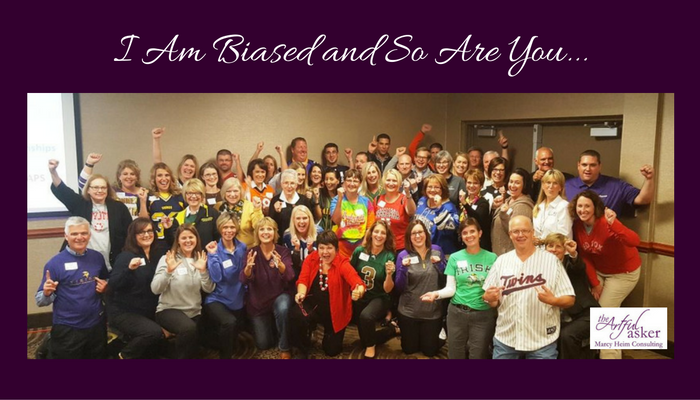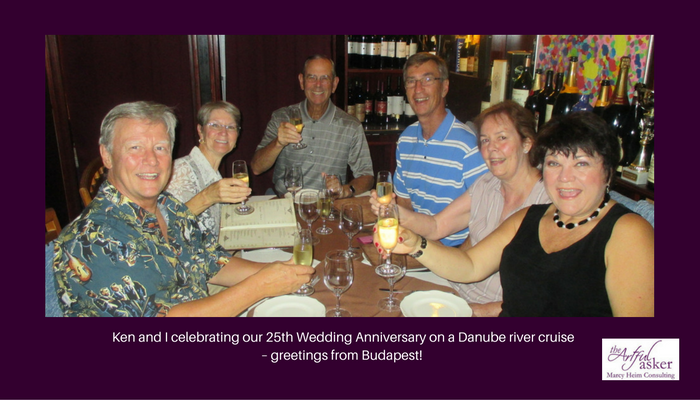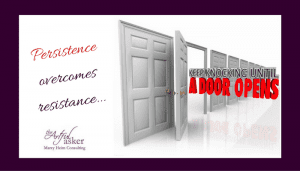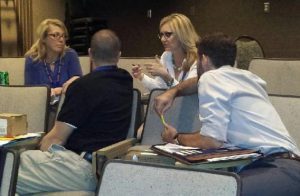
As of October 1st we are officially in the FINAL QUARTER of the year. I can feel it “setting in” with you. YEAR-END, YIKES!
 Like having a baby or buying a home, it’s never the “perfect” time. There are things we wish were different before we jump in – we had more saved, we were at a different salary level, we lived closer to family – whatever.
Like having a baby or buying a home, it’s never the “perfect” time. There are things we wish were different before we jump in – we had more saved, we were at a different salary level, we lived closer to family – whatever.
You just do it a bit scared.
At its core, we are giving in to an outcome we don’t want. Fear. We start, “what if” ing. “What it we can’t handle the payments?” “What if we go crazy with no support?” “What if one of us loses our job?”
Wrong questions. What you focus on grows. What you think about you draw to you. Your thoughts create your actions, and you head down the path towards what you exactly DON’T want. Your inner game creates your outer results.
Over 30% of annual giving happens in December. What will you ask and DO now to have great numbers to celebrate come January?
“What if my major donors are eager to see me?” “What if I have great, warm, productive year-end giving conversations?” “What if our mission is exactly what they want to support?” “Why are so many folks just waiting to hear from me?”
Ok. Now that your head is in the right place, channeling what you believe about where you are differently, perhaps you are wondering if your major relationships are exactly where you want them to make an ask.
Nope.
There is always something you can do to more deeply engage your major donors….
• to help them better understand your organization.
• to be sure they “get” the impact they make.
• to help them have experiences to deepen their connection.
• and to say, “thank you” so they know how deeply you appreciate their support.
But here you are. October. And some of those “next contacts” are from awhile back – undone. In fact, there are many folks who have not heard from you for awhile, quite a while. Or perhaps you are new to your position – and new to all the donors you’d like to engage and ask (or are expected to ask) yet this year.
Here’s what to do NOW.
Five Tips for How To Ask when (you believe) it’s too soon to Ask.
1. Believe in your mission. When you believe, you’ll be believed.
All the research tells us that the main driver to give is that your donor believes in your mission and wants to make a difference. Your deep belief radiates from you as confidence, dedication, and enthusiasm for your mission – and that is infectious.
2. Build rapport. People like people like themselves.
Be polite, pleasant and likable. That means your focus is not on how much information you can transmit on a call about why they should give and NOW! That means you listen, sincerely care about where they are at, and do the little things like mirror their volume and speed of speaking, perhaps adopt a position they are taking – crossing legs, leaning forward and repeat back their words to them.
3. Thank them. ONLY thank them. NO soft asks.
 The research tells us donors who are genuinely thanked are three times more likely to give…and give more. The catch? Insincerity, or remarks like, “and I can’t wait to meet to tell you about our new plans” or “and we look forward to your continued participation in our giving family” or “and we value you as part of our cherished supporters” and on and on. Say “thank you” and shut up.
The research tells us donors who are genuinely thanked are three times more likely to give…and give more. The catch? Insincerity, or remarks like, “and I can’t wait to meet to tell you about our new plans” or “and we look forward to your continued participation in our giving family” or “and we value you as part of our cherished supporters” and on and on. Say “thank you” and shut up.
By letter, phone – message or conversation, email, Board member, student…that sincere, authentic, “Hello. This is Marcy Heim from XYZ where I sit on the Board. I am calling to say, “thank you” for your kind giving to X. It, indeed, makes a difference to _______ (our residents, students, puppies, patients.
Timing is critical. This sincere thanks must happen as a separate touch before any visit/email/letter to ask.
4. Let them know you feel this ask is coming too fast. “I wish I had more time to help you understand how important X is for our mission.”
Transparently sharing that you wish you had more time to have them experience, understand, learn about, your project shares that this isn’t ideally how you’d like to do this. This is easier if your organization stays in touch with mailings or updates throughout the year. Did you do a postcard from a recipient at some point giving the donor an update and thanks? More conversations/touches give us a chance to listen and hone in on what is important to our donor so we can frame the ask amount and project to what most deeply resonates with them. Sometimes we have to ferret this out in one call. “So I’m hearing X is important to you?” or “Based on your impressions of us, do you think we are doing a good job of addressing X with our programs?” “Some unplanned needs have developed, and we are looking to our best friends to help right now.” “We will get a $50,000 match if we can raise the money by X.” These are ways to share why you are moving the relationship along to the Ask before it feels right.
5. Make an Artful Ask.
Write out and practice your Ask ahead according to my 3-sentence ask. You have….You understand…. Would you consider (or hit reply and ask for a copy of my worksheet).
Then let them think about it. I believe most relationship damage is done by pressing and pressuring for an answer. Be sure to be clear when exactly you will call them or stop by again to see where they are with their consideration.
Of course, better than all this is to be implementing your Relationship Action Plans (RAPs) throughout the year so that you and your donor are looking forward to the Ask. Then, this time of year allows you to focus on the segment of your major donors who want to accomplish something by the end of the year.
Would you consider…….
It’s important to reflect on how you are feeling about asking. What are your own feelings about money and wealth? Do you model rich and successful people or resent the heck out of them?
Charge forth this fall! It’s the best time of the year! Remember I’m intending great success for you!

 Now, redefine hope as HOPE – Harness Our Positive Energy!
Now, redefine hope as HOPE – Harness Our Positive Energy!




















 1. The Smith Auditorium. This was a remodel of an existing space in a campus building. The donor named the room after her late husband. The gift request was exactly what we had been told it would cost to build, rounded up to a whole number. This room got a great deal of use for conferences and big lectures – GREAT. But after 5 or 6 short years it had lost its luster, and campus funds were impossible to get. The donor returned for a visit and was pleased….and unhappy.
1. The Smith Auditorium. This was a remodel of an existing space in a campus building. The donor named the room after her late husband. The gift request was exactly what we had been told it would cost to build, rounded up to a whole number. This room got a great deal of use for conferences and big lectures – GREAT. But after 5 or 6 short years it had lost its luster, and campus funds were impossible to get. The donor returned for a visit and was pleased….and unhappy. 
